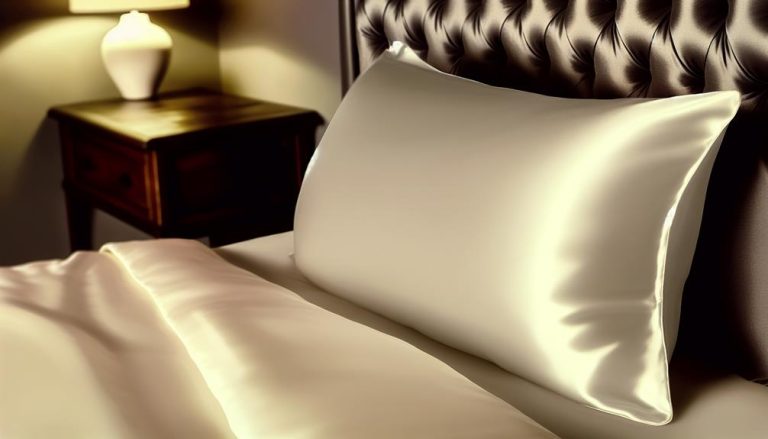They say, 'Don't judge a book by its cover,' but when it comes to our skin, it's hard not to. As individuals with sensitive skin, we know the struggle of finding the perfect fabric that won't leave us itching and uncomfortable.
Satin, often mistaken for the luxurious silk, may not be the best choice for our delicate skin. But why? Well, let's just say that satin's synthetic composition and lack of softness are just the tip of the iceberg.
In this discussion, we will uncover the hidden truths about satin and explore the superior benefits of silk that may have you rethinking your fabric choices. Trust me, you won't want to miss out on this.
Differences Between Satin and Silk
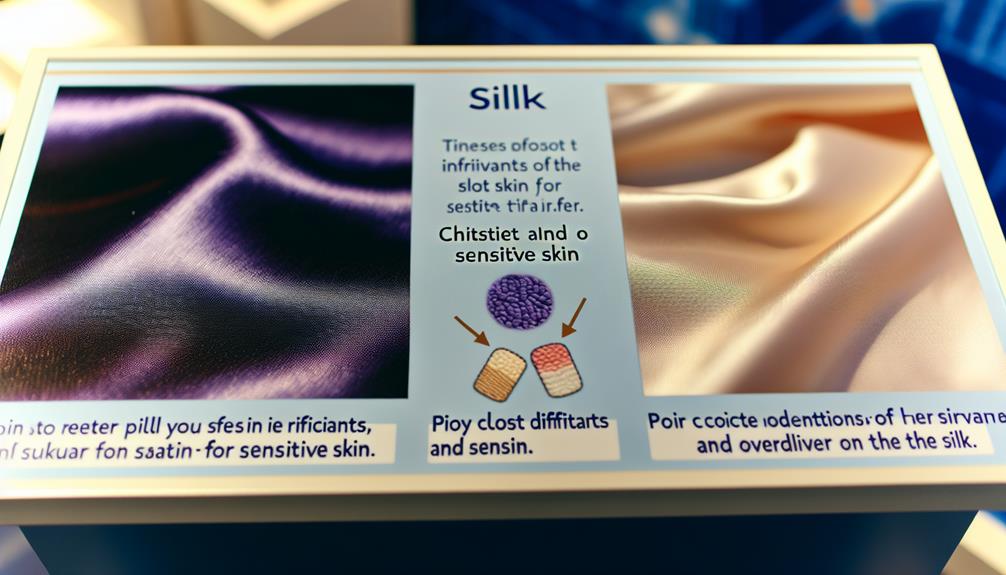
When it comes to choosing between satin and silk, it's crucial to understand the key differences between these two fabrics, as they can have a significant impact on the comfort and health of sensitive skin.
Satin is a synthetic fabric made from materials like rayon or polyester, while silk is a natural material known for its breathability, hypoallergenic properties, and superior softness. Unlike satin, silk has the ability to retain skin moisture, preventing dryness and promoting overall skin health.
Satin, on the other hand, can irritate sensitive skin and even promote acne breakouts due to its synthetic nature. Choosing silk over satin can provide liberation for individuals with sensitive skin, offering them the comfort and well-being they desire.
Properties of Satin Fabric
Satin fabric, often mistaken for silk, is a synthetic material made from rayon or polyester, lacking the softness and natural advantages of its luxurious counterpart. Here are four properties of satin fabric that make it less than ideal for sensitive skin:
- Limited softness: Satin fabrics may feel smooth to the touch, but they lack the unparalleled softness of natural silk. Imagine wrapping yourself in the gentle embrace of silk, caressing your sensitive skin with every movement.
- Synthetic composition: Satin is made from synthetic fibers like rayon or polyester, which can contain chemicals used in the manufacturing process. These hidden toxins can potentially irritate sensitive skin, trapping you in discomfort.
- Lack of breathability: Unlike silk, satin isn't breathable. It creates an environment that hinders airflow, causing heat and moisture to become trapped against your skin. Liberation means choosing fabrics that allow your skin to breathe freely.
- Absence of hypoallergenic properties: Silk is known for its hypoallergenic nature, making it suitable for even the most sensitive skin. Satin, on the other hand, lacks this advantage, increasing the risk of skin irritation and allergy flare-ups. Embrace liberation by selecting fabrics that prioritize your skin's well-being.
When it comes to sensitive skin, satin may not be the best choice. By understanding the properties of satin fabric, you can make informed decisions that prioritize your skin's comfort and liberation.
Satin and Skin Problems
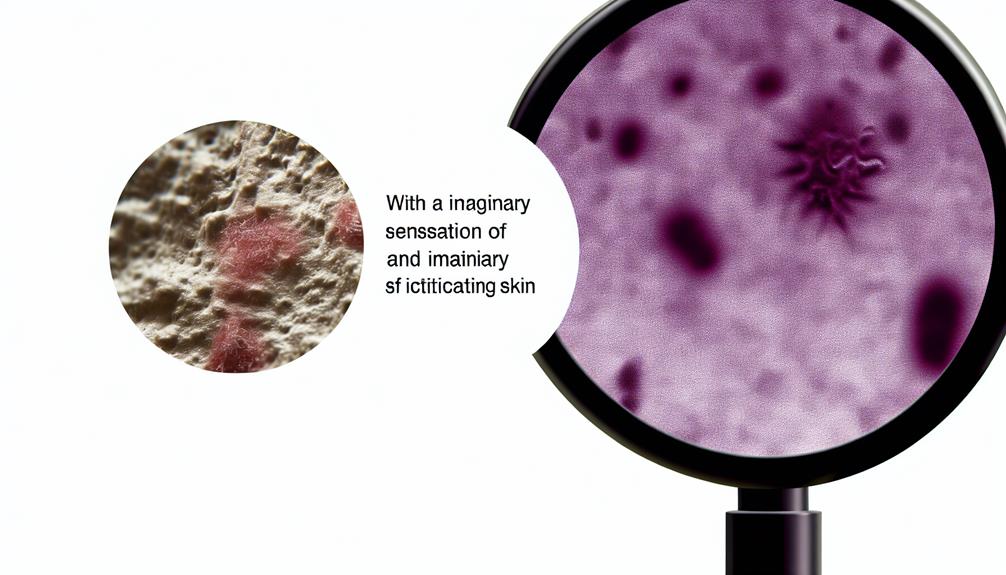
With its limited softness, synthetic composition, lack of breathability, and absence of hypoallergenic properties, satin fabric presents a host of challenges for those with sensitive skin. Satin linens and clothing can be a nightmare for those of us who long for skin liberation.
The synthetic fibers used in satin can trap bacteria, leading to pesky acne breakouts that leave our skin feeling irritated and inflamed. And let's not forget about the lack of hydration satin provides. Without the ability to retain moisture like silk, satin can leave our skin feeling dry and parched.
Plus, satin's lack of breathability and hypoallergenicity only add fuel to the fire, increasing the risk of skin irritation and allergy flare-ups. So why not choose silk instead? Silk's natural, breathable, and hypoallergenic properties make it the perfect choice for sensitive skin, providing the comfort and liberation we deserve.
Benefits of Silk for Sensitive Skin
Silk, with its multitude of benefits for sensitive skin, is the ultimate solution for those seeking comfort and relief. Here are four reasons why silk is the go-to choice for individuals looking to liberate their skin:
- Durable: Silk is known for its strength and resilience, ensuring that your silk products will stand the test of time, even with frequent use and washing.
- Hypoallergenic: Say goodbye to redness, itching, and irritation. Silk is naturally hypoallergenic, making it a gentle and safe option for those with sensitive skin.
- Ultra-soft: Experience pure bliss against your skin. Silk's luxurious texture is unmatched, providing unparalleled softness and comfort.
- Breathable: No more sweaty nights or stifling clothes. Silk's breathability allows for proper airflow, keeping your skin cool and preventing moisture buildup.
Sensitive Skin Care Tips
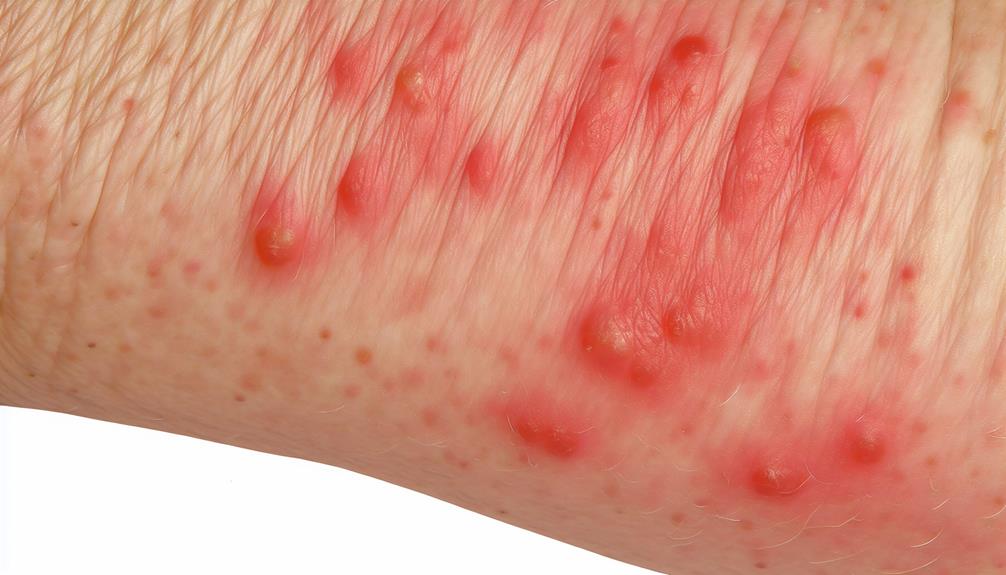
For those with sensitive skin, taking care of your skin is essential in maintaining its health and preventing irritation. Here are some sensitive skin care tips to help you keep your skin calm and comfortable:
| Tip | Description |
|---|---|
| Try natural home remedies | Soothe itchy or irritated skin with oatmeal baths, honey, or apple cider vinegar. |
| Keep your skin moisturized | Apply moisturizer on damp skin after showers or baths to prevent dryness. |
| Switch to silk pillowcases and robes | Opt for silk pillowcases and robes made from 100% mulberry silk, like Blissy Silk Pillowcases and Classic Robes. They offer exceptional softness for sensitive skin. |
| Choose fabrics suitable for sensitive skin | Select clothing made of fabrics that are gentle on the skin to avoid acne, rashes, itching, and other skin problems. |
| Combine skin care tips with silk | By incorporating these skin care tips and using silk products, you can provide additional protection against skin irritation. |
Taking these steps will help you protect your sensitive skin and ensure it stays healthy and comfortable.
Satin's Synthetic Composition
Satin, unlike silk, is composed of synthetic materials like rayon or polyester, making it a popular choice for its affordability and versatility. However, the synthetic composition of satin comes with some drawbacks that may not sit well with those who desire liberation for their sensitive skin.
Here are four reasons why satin's synthetic composition may not be the best choice:
- Hidden toxins: Synthetic fibers used in satin can contain chemicals used in the manufacturing process, potentially leading to hidden toxins in satin products. This can be worrisome for individuals seeking liberation from harmful substances.
- Limited softness: Satin fabrics have limited softness compared to silk. So, if you crave the luxurious touch of silky smoothness against your sensitive skin, satin mightn't deliver the liberation you desire.
- Lack of breathability: Satin isn't breathable like silk. This means that it may trap heat and moisture, leading to discomfort and increased risk of skin irritation or allergy flare-ups. Liberation comes in the form of breathable fabrics that allow your skin to breathe freely.
- Missing hypoallergenic benefits: Unlike silk, satin isn't inherently hypoallergenic. This means that it may increase the risk of skin irritation and allergic reactions, hindering the liberation you seek for your sensitive skin.
When it comes to sensitive skin, liberation can be found in choosing natural alternatives like silk, which offer superior comfort, breathability, and hypoallergenic properties. So, before you make your next purchase, consider the composition of the fabric and opt for liberation through the gentle touch of silk.
Satin's Lack of Softness Compared to Silk
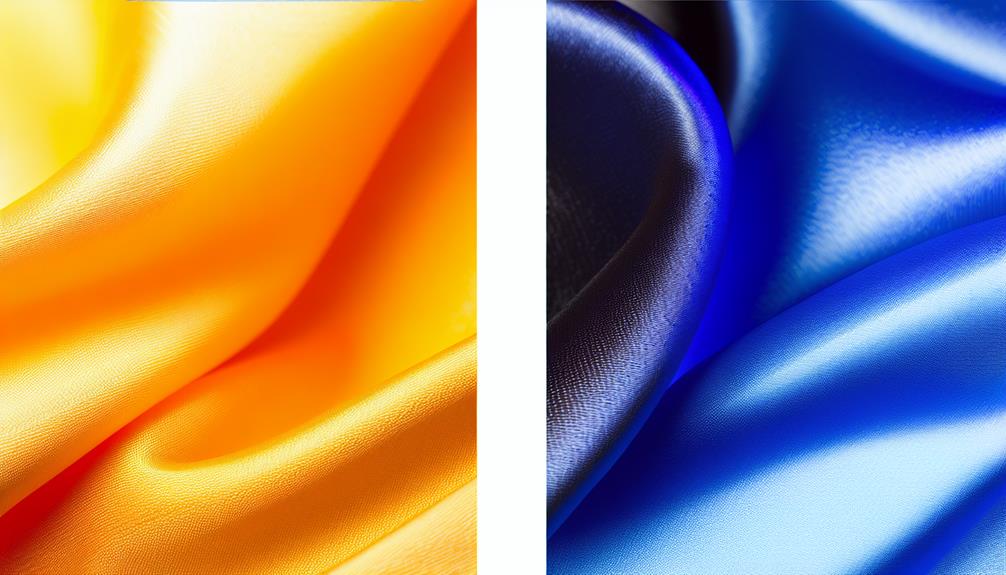
With its synthetic composition, satin lacks the luxurious softness that silk offers, leaving sensitive skin longing for a more gentle touch. Silk, with its natural fibers, has a softness that is unparalleled. It caresses the skin, providing a soothing and comforting sensation. In contrast, satin feels rough and coarse against sensitive skin, causing irritation and discomfort. To truly understand the difference, let's compare the two fabrics side by side:
| Satin | Silk | |
|---|---|---|
| Softness | Limited softness | Superior softness |
| Comfort | Rough and coarse | Smooth and gentle |
| Sensation | Unpleasant and scratchy | Luxurious and indulgent |
As you can see, satin simply cannot compete with the softness and comfort that silk provides. For those with sensitive skin who crave liberation from discomfort, silk is the clear choice. Embrace the liberation of silk and experience the ultimate in softness and comfort for your delicate skin.
Satin's Potential Hidden Toxins
As we explore the potential hidden toxins in satin, it becomes evident that the synthetic nature of this fabric may pose risks for individuals with sensitive skin. Here are four reasons why satin's hidden toxins should concern you:
- Chemical exposure: Satin fabrics are made from synthetic materials like rayon or polyester, which can contain chemicals used in the manufacturing process. These chemicals have the potential to irritate sensitive skin and cause allergic reactions.
- Skin irritation: Satin lacks the breathability and hypoallergenic properties of natural silk. This means that individuals with sensitive skin may experience increased skin irritation and allergy flare-ups when in contact with satin.
- Acne breakouts: The satin weave creates an environment that attracts bacteria, leading to acne breakouts. For those with sensitive skin, this can be a nightmare, as satin linens and clothing may exacerbate existing skin problems.
- Unknown long-term effects: Due to the synthetic nature of satin and the potential presence of hidden toxins, the long-term effects on sensitive skin are uncertain. It's important to prioritize your skin's health and consider alternatives like silk, which offers superior benefits for sensitive skin liberation.
Silk's Superior Breathability and Hypoallergenic Properties

Silk's breathability and hypoallergenic properties make it the ideal choice for individuals with sensitive skin. When it comes to finding the perfect fabric for your skin, silk stands out as a superior option. Its natural fibers allow air to circulate freely, keeping your skin cool and comfortable. Unlike satin, which can trap heat and moisture, silk helps regulate body temperature and prevents excessive sweating.
This breathability is crucial for individuals with sensitive skin, as it reduces the risk of irritation and breakouts. Additionally, silk is hypoallergenic, meaning it's less likely to cause allergic reactions or skin irritation. Its smooth and soft texture provides a luxurious sensation against your skin, ensuring a comfortable and liberating experience.
When it comes to caring for your sensitive skin, choosing silk is a decision that will leave you feeling refreshed and confident.
Frequently Asked Questions
Can Satin Cause Acne Breakouts?
Satin can cause acne breakouts. It's a synthetic fabric that lacks the breathability and hypoallergenic properties of natural silk. The satin weave creates an environment that attracts bacteria, leading to skin problems.
Additionally, satin doesn't retain moisture like silk does, which can result in dry skin. Choosing silk over satin is a better choice for individuals with sensitive skin, as it soothes and protects the skin while providing superior softness and comfort.
Does Satin Retain Moisture in the Skin?
Satin doesn't retain moisture in the skin like silk does. It's a synthetic fabric that lacks the hydrating properties of natural silk. Satin can actually contribute to dryness and discomfort for individuals with sensitive skin.
Unlike silk, satin doesn't have the same ability to regulate body temperature or provide a cooling effect. That's why choosing silk over satin is a better option for maintaining moisture and overall skin health.
Is Satin Breathable and Hypoallergenic?
Yes, satin isn't breathable and hypoallergenic. It can cause skin irritation and allergy flare-ups for individuals with sensitive skin.
Satin weave attracts bacteria and can lead to acne breakouts. Additionally, satin lacks the hydrating properties of silk, potentially causing dry skin.
Choosing silk over satin is a better option for sensitive skin as it's a natural material with benefits like breathability, hypoallergenic properties, and superior softness. Silk can help soothe and protect sensitive skin, promoting overall skin comfort.
Can Silk Help Regulate Body Temperature?
Yes, silk can help regulate body temperature.
Silk is a natural material that's known for its breathability and ability to wick away moisture.
This means that it can keep you cool in hot weather and warm in cold weather.
Silk's unique properties make it an excellent choice for individuals with sensitive skin, as it helps to maintain a comfortable and balanced environment for the skin.
What Are Some Natural Remedies for Sensitive Skin?
Some natural remedies for sensitive skin include:
- Soothing oatmeal baths
- Applying honey or apple cider vinegar to alleviate itching and irritation
To prevent dryness, it's essential to:
- Keep the skin moisturized by using a moisturizer on damp skin after bathing
Additionally, switching to silk pillowcases and clothing can provide:
- Exceptional softness and comfort for sensitive skin
These remedies, combined with carefully selected clothing like silk, can help protect against:
- Acne, rashes, and other skin problems.
Conclusion
In conclusion, when it comes to sensitive skin, satin may not be the best choice. Unlike silk, satin lacks the natural benefits that can enhance skin comfort. Satin can irritate sensitive skin, promote acne breakouts, and lead to dryness.
On the other hand, silk is known for its breathability, hypoallergenic properties, and superior softness. By opting for silk products like pillowcases and robes, individuals with sensitive skin can better care for their skin and prevent skin problems.
Choose silk for a truly luxurious and gentle experience.


